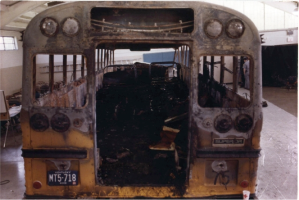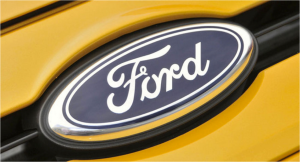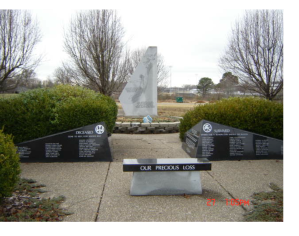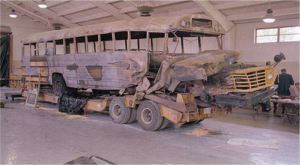Bus Developments Despite Tragedy
Kody Maikranz
“From tragedy comes wisdom.” (Mead) This quote was once written in the Lexington Herald-Leader, by journalist Andy Mead, referring to the Carrollton Bus Crash of 1988. This crash occurred on Interstate 71, where a drunk driver, Larry Mahoney, crossed the medium and hit an oncoming bus full of children returning from a church camp. This accident killed 27 and seriously injured 34 of the 67 passengers on board. This is considered one of the worst bus crashes to ever happen in the United States. Through the Carrollton Bus Crash many significant improvements have resulted that has forever impacted the world of transportation, as we know it.
Larry Mahoney, the drunk driver responsible for the crash, crossed the medium on Interstate 71 and ended up hitting the Carrollton County church bus headed the opposite direction. This horrifying accident could have been prevented by two simple things: stricter legislation on keeping drunk drivers off the roads, and the creation of laws that require more safety regulations on the hazardous buses on the roads. I am going to focus more on the bus and the handful of things that went wrong with the current bus technology at the time of the crash.
The first problem that came up after the crash was the front exit of the bus was blocked by Mahoney’s car. This left only the rear emergency exit for the passengers on board to depart. This created additional problems when the exit was blocked by the cooler, which they used on their trip to Kings Island, and other debris from the crash leaving the kids on board with no way to leave the bus. This was the first main problem that occurred after the crash, which leads me to my next point.
You’re probably thinking why didn’t the kids exit out of the windows? The buses prior to the strict bus regulations required no emergency push out windows or top emergency hatches. An open window allowed approximately a ten-inch clearance to exit the bus, much too small for even the smallest child to exit (Mead). With both the front and back exit partially blocked, it restricted the amount of children that could exit the bus quickly and efficiently. All these deficiencies in the bus technology are minor compared to the next problem that occurred in the crash.
When Larry Mahoney’s pick up truck hit the bus head on, a spring from his vehicle punctured the buses fuel tank. Eventually the fuel leak was ignited by sparks from the collision, which resulted in an explosion that engulfed the inside of the bus. This defect was due to the poorly placed fuel tank by Ford Motor Company. The fuel tank was positioned behind the exterior panel just outside the heavier denser frame of the bus. The tank was located right under the stairwell for the bus, which happened to be the exact location where Mahoney’s truck collided (Mangahis). The fire and smoke provoked chaos inside the bus, as kids tried to escape through the only emergency exit in the back of the vehicle. I recently interviewed Jason Booher, survivor of the 1988 bus crash and now advocate for speaking to young kids about the hazards of drinking and driving, he said “After the initial impact (of Mahoney’s Car) the confusion was exemplified with the explosion and smoke, as it began to fill inside the cabin of the bus.” As you can see, the smoke and fire created fear into the already terrified passengers on that church bus back in 1988. This problem added with the final issue with the bus technology escalated the situation severely.
The final issue was a minor problem that greatly affected the outcome of the crash and overall prohibited the kids from exiting the bus safely and quickly. This issue was the alignment and makeup of the bus seats. The alignment of the bus seats was a major issue because it created a narrow passageway for the passengers to enter and leave the bus, especially since the only possible route of exit was through the back emergency exit. The width between the rows of seats was only a mere 12 inches. The narrow 12-inch aisle of the bus constricted the amount of kids that could exit the bus quickly during the wreck. As more and more kids tried to exit, they would trip over the bodies and debris already blocking the narrow aisle. This combined with the chaos of the fire and smoke had kids climbing frantically over seats to reach the back emergency exit. Jason Booher, when talking about the issue of small aisles, said “There was little space to maneuver especially when the smoke only allowed you to see a couple feet at a time,” As you can imagine this situation was escalated through the narrow aisles in a frantic situation.
The second issue with the seats was the structure of the seat itself. The materials used to compose the seats were highly flammable, and would catch fire in a matter of seconds. The seat cushions contained highly flammable polyurethane foam padding, which was easily ignited after the explosion. This allowed the fire to quickly spread after the explosion of the fuel tank. This explosion engulfed the bus pushing the temperature inside to an estimated 2000 degrees Fahrenheit (Mangahis). Along with the extreme heat and fire, was the noxious gas produced by burning the seats. Both the gas and fire spread throughout the bus in less then 3 minutes. Fire was the main cause of death, which resulted in 27 fatalities out of 67 people. These are just a few of the many inadequacies that helped escalate the devastation caused by the Carrollton Bus Crash of 1988.
As you can see the severity of this accident could have been avoided given the proper safety equipment and regulations on the buses of that time. Through this accident various legislation has been passed that has had an over all impact on the quality of buses produced after 1988. Some of the major changes that were brought about through the crash include the following: requiring buses are required to have addition emergency exits along with push out windows and emergency hatches, placement of gas tank in a more ideal location along with other issues involved with the gas container, the use of less flammable fuel and materials used in the construction of the seats, and finally stricter regulations on bus safety and maintenance.
The first change that was brought about due to the bus crash was the additional emergency exits and push out windows that are required by state and federal safety standards. After the wreck the National Transportation Safety Board (NTSB) acclaimed that the number of doors on the bus must correlate with the number of passengers the vehicle can occupy. The National Highway Traffic Safety Administration (NHTSA) agreed with the National Transportation Safety Board and made this proclamation into law in 1996 (Davis). This law stated exactly what the National Transportation Safety Board proposed, that the total area of emergency exits is to be based on the designated seating capacity, if this standard cannot be met by the primary front entrance door and rear emergency exit, then the law must be met by the bus manufactures by including forms of left and right side doors, emergency push out windows, along with roof exits. This alone could have saved nearly everyone involved in the Carrollton Bus Crash of 1988, and has continued to save lives in bus crashes since 1996.

The only available route of exit was the rear emergency exit, which only provided space for one person to exit at a time. (Photo 3)
The next change that came about due to the bus crash of 1988 was the placement of gas tank in a more ideal location along with the use of a less flammable fuel source. The first order of business brought to the table by the National Transportation Safety Board was the placement of the fuel tank by Ford Motor Company. The fuel tank originally placed underneath the stairwell was to be moved to the side of the bus away from all exits. The National Transportation Safety Board believed that this was the least likely location for a collision to occur thus being the most ideal and logical place to put the fuel tank (Davis). They also thought that the fuel tank should no longer be placed by an exit, so if explosion does occur it wouldn’t be able to keep passengers from exiting the bus. This was the first issue dealing with the gas tank.
The next law that was established was the use of diesel fuels in the buses, rather then the very flammable regular gasoline. Diesel fuel takes longer to start burning compared to gasoline. The National Transportation Safety Board believed the use of diesel to be more ideal for public transportation buses because if a crash does occur it will take longer for that fuel to ignite (Davis). As you can see, both the use of alternative fuel source and the fuel tanks placed in less exposed areas of the bus helped make the use of school buses safer for everyone.
The next modification and probably the most significant fix for the school buses was the use of less flammable materials when constructing the seats. This is considered the most important because out of the 27 victims of the crash all of them died due to fire related injuries. The bus and passengers withstood the impact of Mahoney’s car but the flammable seats didn’t allow the kids to evacuate the bus quickly enough. As I stated previously the temperature inside the bus at the time of the crash was estimated to be around 2000 degrees Fahrenheit. This was acted upon by state legislature requiring all buses in the state of Kentucky to install flame retardant seats and cushions. This cost around 100 dollars per seat on new buses and 2,200 dollars per seat on the old model buses (Wolfe). Transportation Secretary Milo D. Bryant, chairman on the Task Force on Bus Safety said, “School buses are not sold unless they are safe at the time they are sold.” (Wolfe) In this quote Milo D. Bryant was talking not only about the newly enacted laws on the flammability of the seats but also the overall safety of the new technology on the buses, in that no new buses should be sold until they figure out or determine the best way to keep the passengers safe in a worst case scenario situation. This cost the state a lot of money and was widely debated. Charlie Gauthier, Executive Director of the National Association of State Directors of Pupil Transportation Services said, “When it comes to issues of safety in pupil transportation, those that have the responsibility to establish public policy, whether it be in the form of laws, standards or regulations, have an obligation to make their policy decisions based on data and science, not emotion and supposition. Since our society does not have sufficient resources to do everything we would like, we must invest those limited resources in solving problems that can be proven to prevent unreasonable risks to our safety.” Charlie Gauthier was saying that we should not produce these acts of law purely on emotion, but on reason (“National Association of State Directors of Pupil Transportation Services”). He continues to say that we should not spend money to revolutionize the bus technology if it is not necessary for the overall safety and well-being of its passengers. In this case the use of less flammable materials in the construction of the seats was deemed necessary and put into law in 1990 (“National Association of State Directors of Pupil Transportation Services”).
The last legislative law that was produced after the bus crash of 1988 was the standard on the buses along with the qualification of bus drivers was raised in the state. Publicly owned buses had to undergo regular safety inspections that meets state and federal bus regulations. Their drivers were required to do bus evacuation drills, but this only applied to the buses within the school system. After the bus crash of 1988 it was reported that the state looked at all the buses being used in public transportation. Out of 1,623 buses and 2,305 other public transportation vehicles, they found a total of 715 with major safety defects. Out of that 715,160 buses were in such horrible shape that the state feared they could hurt the overall welfare of the people in Kentucky that they ordered them immediately off the roads (Mead). This increase in guidelines and procedures has improved the public bus transportation system, as we know it. As you can see many steps were taken to ensure that this accident would never occur again, and if they do happen to occur again the crash wont be of the magnitude of the Carrollton bus crash of 1988.
The next step towards ratifying the laws was the judicial process with the accusations against Ford. This brought legalistic issues dealing with product liability and the poor placement of the fuel tank when designing the school bus. Ford Motor Company was held accountable along with Superior Coach Company, the other bus manufacture involved. Many lawsuits were filed against Ford Motor Company by the families involved with the crash. They believed that the poor designs involved with the bus directly corresponded with the fatalities and injuries on board. Ford Motor Company, never really admitting to their fault, complied they offered compensation to all families involved. They promised 700,000 dollars to the deaths of family members and payments on a descending scale for the people injured in the crash. They also donated over 500,000 dollars to fund organizations that fight against drunk drivers (Carrolton School Bus Crash).

The families of the crash blamed Ford for the poor design and overall production of faulty products. (Photo 4)
However this was not enough for some of the family members believing Ford acted “recklessly, willfully and wantonly, consciously disregarding the danger they were creating,” after ignoring governmental experts and their own engineers on the fuel tank being outside of the dense frame (Carrolton School Bus Crash). The Nunnalle’s, who had a 10 year old die in the crash, proposed that they would accept one dollar if Ford would simply recall the 19,200 Ford-Built 1977 school buses on the road and install a safety cage around the fuel tank. Ford, however, rejected this proposal and refused to act, stating that “it would cost more to protect the buses then it would to actually produce them.” This comment could be construed as Ford’s selfishness and greed for money was greater than their concern for the safety and well being of the passengers. This lack of action by Ford caused the Nunnalle and Fair family, both having young daughters in the crash, to file a 159 million dollar lawsuit. Ford ended up losing the lawsuit and was forced to give 3 percent of their yearly profits to these two families (Carrolton School Bus Crash). Ford ultimately took large steps to correct the inadequacies with their bus design, not to mention all the extra safety features they installed onto their newer models of buses.
Through the Carrollton Bus Crash many great things resulted despite the atrocious tragedy that occurred on May 14, 1988. From this accident the world of transportation was revolutionized for the better. The innovations involved through this crash will forever have a lasting impact on the world of transportation and society as a whole. As Andy Mead said almost twenty-three years ago “From tragedy comes wisdom.” (Mead), Great wisdom resulted from this misfortune.
Citations:
-Booher, Jason. Personal Interview. 25 Nov 2011.
-Charles, Wolfe. “FLAME-RESISTANT SEATS MAY BE REQUIRED ON NEW SCHOOL BUSES.” Lexington Herald-Leader 21 10 1988, Final C3. Print.
-Davis, Leon. “A Look Back at the Carrollton, Ky., Tragedy.” School Bus Fleet . Bobit Buisness Media, 2011. Web. 6 Dec 2011. <http://www.schoolbusfleet.com/Channel/School-Bus-Safety/Articles/1998/04/A-Look-Back-at-the-Carrollton-Ky-Tragedy.aspx>
-Mangahis, Jade. “Bus Crash of 1988.” Social Media (R)evolution. Social Media (R)evolution, April 13, 2010. Web. 6 Dec 2011. <http://socialmediarevolution.blogspot.com/2010/04/bus-crash-of-1988.html>.
-Mead, Andy. “THE CHURCH- BUS TRAGEDY LESSONS LEARNED.” Lexington Herald-Leader December 18, 1988. FINAL E1. Web. 5 Nov. 2011
– Photo 1. http://www.findagrave.com/cgi-bin/fg.cgi?page=gr&GRid=12894909
-Photo 2. http://areasonableservice.wordpress.com/2009/10/09/st-pauli-girl/
-Photo 3. http://lancasteronline.com/article/local/252760_Life-changing-moment.html
-Photo 4. http://www.leftlanenews.com/ford-in-tough-position-for-union-negotiations.html
– “Term Papers.” Carrolton school bus crash. Collegetermpaper.com, 2011. Web. 20 Nov 2011. <http://www.collegetermpapers.com/TermPapers/Miscellaneous/Carrolton_school_bus_crash.html>.
-United States. National Association of State Directors of Pupil Transportation Services. (1997-2000): “Appendix D.” 1-37. Web.


